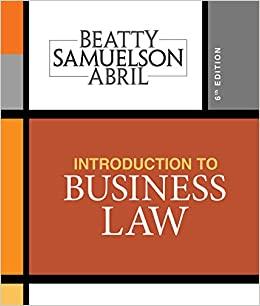Question
Asap please You will consider the ethical consequences of the facts below and write short paper about the relevant ethical issues. Do no outside research.
Asap please
You will consider the ethical consequences of the facts below and write short paper about the relevant ethical issues. Do no outside research. You do not need to use citations.
To begin, read the Jennings Ethics Models, attached. That is the "Law" you will apply to the below "Fact Pattern".
Next, for your paper discuss the ethical issues, in this order:
First identify four different ethical dilemmas you can recognize in the below Fact Pattern. Briefly explain the dilemma and why you believe it is unethical. The Jennings Models include examples of common ethical dilemmas encountered in the business world. Use some of those examples here and evaluate how the four Jennings examples you select fit the facts. Part A should be no more than two sentences for each dilemma. Use bullet points for Part A.
B. Then, choose two of the four dilemmas you selected in Part A.
For each of those two dilemmas, evaluate each one from two other impacted party's perspectives.
For example, what would the insurance company think of the plan? What would a government criminal prosecutor think? What would your own boss at the supermarket think? What would the lawyer's own employer think? (There are many such potential "impacted" parties.)
Part B will have four sub-parts, two parts for each dilemma. Use prose here, not bullet points.
Lastly, use two of the Jennings Ethics Models (the Law) to evaluate and resolve the situation. Here, you will apply the "Jennings Law" to the below "Facts". Use prose here, not bullet points.
Grading Rubric
Your paper will be graded based on the logic, depth, and coherence of your argument and on the application of the Jennings Law to the below Fact Pattern. Your writing should be clear and grammatical, with no spelling errors. The paper should be double spaced about four pages, using 12 pt. type. Submit the paper online in BbLearn through Turnitin .
Case Fact Pattern
An employee at the supermarket you manage mopped one of the aisles in the store and placed signs at the ends of the aisle to warn people not to use the aisle until the floor dried. One customer walked around the sign, slipped, fell, and suffered serious injuries. Her lawyer comes to you with the following story. The lawyer says that he is going to sue the store for the negligence that led to the customer's injuries. However, he says that he doubts that he can win, since case law in the state makes it clear that the sign is considered a reasonable warning so that contributory negligence by the customer would eliminate the liability of the store. This means that the customer will get nothing, but one can never be completely sure. The worst part is that the customer has no insurance, has incurred large hospital bills, cannot work for a few months, and has no source of support.
The lawyer makes the following deal. He will forgo any fee for the case and will sue only for an amount equal to the medical costs incurred and the wages lost, if you will agree to testify that there was no sign in place to warn that the floor was wet. The insurance company will make the payment, not the supermarket. The lawyer says this will not affect your position with the supermarket, and your supermarket will save attorney's fees since there will be a limited lawsuit.
Should you make such a deal? What if you knew that the law in most states would provide an award because their laws hold that warning signs are insufficient, and a complete physical barrier must be in place? Discuss the ethical issues as instructed above.
Step by Step Solution
There are 3 Steps involved in it
Step: 1

Get Instant Access to Expert-Tailored Solutions
See step-by-step solutions with expert insights and AI powered tools for academic success
Step: 2

Step: 3

Ace Your Homework with AI
Get the answers you need in no time with our AI-driven, step-by-step assistance
Get Started


